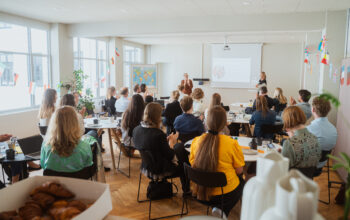
This blog summarises the webinar “Integrating Circularity into Product Development”. Watch the webinar by following this link.
Working towards a circular economy is a central means of transitioning towards a society that is operating within the planetary boundaries, by having more sustainable ways of producing, using, and retaining the value of products.
However, the practical challenges of implementing circular principles in product design can be considerable. Circular product design requires new types of collaborations across silos and departments, evaluating tricky trade-offs, and even rethinking business models.
Despite the challenges, many companies are choosing to invest in doing so. For example, Grundfos and Danfoss who were featured in the webinar.
Why integrate circularity into product development?
We see that companies are working with circularity integration to maintain their position as responsible companies as well as in the pursuit of the following benefits:
Build resilience
Recover material value
Price shocks and shortages during COVID as well as continued rising material costs, send a strong signal that maintaining control over the materials and components can be not only more sustainable but also mitigate against supply risks.
Capture new sources of value
Circular business models can offer opportunities to gain value not just once when the product is sold, but over the lifespan of the product.
It is really important to be looking at more than just the technical part (of circularity) but also at circular business models. Selling products-as-a-service, can be both more profitable and improve data availability and understanding.
Enable strategic performance
Reach climate targets
Many companies will not be able to reach their climate targets without rethinking how they use materials and diversifying value streams to include services. Nearly one-third of the world’s largest companies have committed to net-zero, yet almost all will not reach their targets without at least doubling the pace of emissions reduction by 2030.
Prepare for regulation
Get ready for a policy landscape that is gearing towards circularity
The circular economy is a key pillar of the EU’s economic development plan, the EU Green Deal, which aims to decouple economic growth from resource use.
See our webinar on EU circular economy policy to learn more, with two key take-aways including:
- There will be greater transparency, with mandatory reporting on how companies incorporate circular principles into strategy, business models, and product design.This will be seen with the reporting requirements under the Corporate Sustainability Reporting Directive (CSRD) and European Sustainability Reporting Standards (ESRS), and specifically the ESRS E5 disclosure requirements on Resource Use and Circular Economy.
- Ecodesign requirements will be developed for all products in the EU (except food, feed, and medical products) under the proposed Ecodesign for Sustainable Products Regulation (ESPR). The exact requirements are still under development but will be based on circular design principles. Companies are choosing to start integrating circular design today to reduce future risk.
Seven lessons learned
From our experience and the discussions in the webinar, we have identified seven lessons. We recommend companies to keep these lessons in mind to effectively integrate circularity into product development.
1. Circularity integration starts with strategy and business models
It is commonly thought that product design determines 80% of a product’s lifecycle impact. However, underpinning the decisions made in product design are the commercial and sustainability strategies as well as the choice of business model. Circular product development won’t take off unless aligned with organisational strategy.
At Danfoss we made a conscious effort to embed circularity into our business strategy and choose circularity as one of the key enablers. This high-level commitment gives us a mandate to work with it and puts more pressure on the organisation.
2. Support from the top management is key
Senior level buy-in is essential for circular product development to be realised. Of course, having employee buy-in at all levels is important. However, the organisational changes required cannot be realised unless top management is behind the agenda.
We need to have a top-down approach to drive circularity. Even if people really want to be sustainable, we need to have an argument as to why to put effort into something that is not directly cost related… we need to have the targets and KPIs in place as the most important step.
3. Set targets and continually monitor performance
Setting quantitative key performance indicators (KPIs) and regular monitoring procedures are essential in driving progress. However, there is no one-size-fits all approach; KPIs must be suitable to the company context and product type and must also be adjusted along the way.
4. Use an evidence-based approach, but don’t let a lack of data get in the way of action
Understanding product impacts across the entire lifecycle supports addressing the highest areas of impact and the evaluation of trade-offs. Integrating circularity from the earliest possible stages of product development is key to effectively address impacts, however, this is also when the least amount of information is available.
When lifecycle assessments are not possible, understanding can still be gained from evaluating similar products. Circularity assessment can also be done with semi-quantitative methods using scoring and scenarios. For example, at Grundfos, they are collaborating with a PhD student to integrate circularity into early-stage technology development.
It is important that we are assessing circularity as early as possible… and even in early technology development that we have tools to assess what are the most sustainable and circular options.
5. Integrate into current processes
Amongst all the other competing tasks in product development, true circular product development won’t happen as an add-on. It must be integrated into current product development processes. This is why we recommend companies to start by assessing their current product development processes to identify ‘intervention points’ – these can be tools, documents, and key points in decision making where circularity can be integrated.
6. Bring everyone on board
Product development requires the combined effort of employees with many different areas of expertise, and each of them affect circularity differently. Every employee involved should have a clear understanding of what circularity means for the company, the products they work with, and their decision making mandates.
7. Engage in partnerships
We see that our most successful clients and circularity leaders invest in partnerships to achieve their goals. This includes collaboration with academia and industry coalitions to exchange and gain new knowledge, supply chain partnerships to source more circular materials or parts, and collaborations with customers to pilot circular products or test take-back systems.
By sharing information, we inspire others with our approach, just as we’ve been inspired by others in what we do. We see that this is how we can drive actual circularity forward.
How we work with circularity integration
At Nordic Sustainability, we support organisations to work with circularity, with our approach depending on where they are at in their development.
We simplify the journey into three steps:
1. Understand
Understanding products’ key areas of impact across their lifecycle, the policy landscape, and the organisation’s product development process is foundational to developing an effective strategy.
See how developed a circularity management approach for TOMRA
2. Strategise
Having a strategy with clear targets and KPIs sets an anchor point for decision making to prioritise sustainable and circular product design. We support in clearly scoping initiatives including resource allocation and investments required to achieve the targets that are set.
See how we set Viessmann on the path to be a fully circular company
3. Act
With an understanding established and strategy in place, it’s time for implementation. We support on projects including integrating sustainability requirements into product development processes, implementing tools to assess circularity, and conducting pilot projects.
Book us for a call to hear how we can support on projects
Interested in learning more?
Book a free one-hour circularity session.
The session is commitment free, and you will leave with insights on your company’s maturity on circularity and product sustainability and where to focus your efforts for maximum impact.



